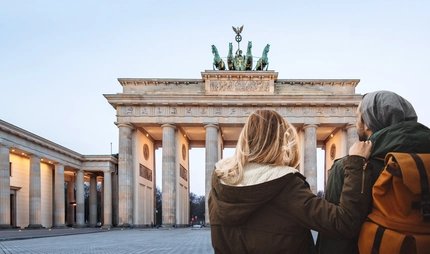
Unter den Linden
Berlin’s magnificent boulevard
From the Berlin Cathedral to the Brandenburg Gate, and many other landmarks in between – the magnificent boulevard Unter den Linden takes you right through the middle of Berlin.
Unter den Linden is one of the most important arterial roads in the centre of Berlin and is the ideal starting point for getting to know the city. The magnificent boulevard in Mitte is the venerable heart of Berlin and takes you from the Brandenburg Gate to the Schlossbrücke and the new Humboldt Forum. Strolling along the 1.5 km long road, you pass numerous important buildings such as the Humboldt University and the Staatsoper, and landmarks such as the Neue Wache and the Zeughaus. The boulevard also boasts restaurants, cafés and shops.
The history of the boulevard Unter den Linden
The street, known commonly as die Linden (after the lime trees that once lined it) is the oldest boulevard in Berlin, but originally it was nothing more than a bridle path. From 1573, it led from the Stadtschloss to Lietzow, which was later renamed Charlottenburg after Queen Sophie Charlotte, and then on to Spandau. The first lime trees were planted in 1647. After 1701, as royal power grew, the road was continually improved and impressive new architecture was built. This was the work of Frederick the Great, who had it upgraded to a magnificent boulevard. That’s why there is an equestrian statue of “der Alte Fritz” at the eastern end of the street.
The buildings that sprang up along Unter den Linden over the years included the Zeughaus, the Friedrichstadt and, under Frederick the Great, the Kronprinzenpalais, the Prinzessinnenpalais, the Opernhaus and the Palace for Prince Heinrich, which is now the Humboldt University. Karl Friedrich Schinkel ensured that the different buildings and architectural styles fitted into a harmonious aesthetic concept. Thus, the Neue Wache and the Schlossbrücke were built and the Lustgarten redesigned, turning the boulevard into a complete ensemble. In the late 19th century, the Berliner Dom was rebuilt in the eclectic style of the Wilhelmine era.
After the Second World War, Unter den Linden was little more than a wasteland of rubble – except for the Stadtschloss. But in 1950 Walter Ulbricht, the General Secretary of East Germany’s ruling party, decided to demolish the Stadtschloss. As a symbol of Prussian absolutism it was a thorn in his eye. The other still extant buildings were gradually rebuilt, but the real construction work began in 1958, when typical 1960s buildings with identical façades started to go up. In place of the Stadtschloss, the Palast der Republik was built. After reunification it was found to be contaminated with asbestos and had to be pulled down.
Unter den Linden today
Since reunification, many buildings have been restored and rebuilt. The Lustgarten – which was used as a parade ground by the GDR – became a garden again, just as Lenné’s original plans intended. Just opposite, the Humboldt Forum opened in 2020: State-of-the-art interactive exhibitions await you on an area of around 30,000 square metres and spread over five floors.
Sights along Unter den Linden:
- Brandenburg Gate
- Museum Island
- Humboldt Forum
- Staatsoper Unter den Linden
- Berlin Cathedral
- Zeughaus
- Neue Wache
Hotels
If you want to stay directly in the centre of Berlin, we can help you find hotels near Unter den Linden and in Berlin-Mitte.




